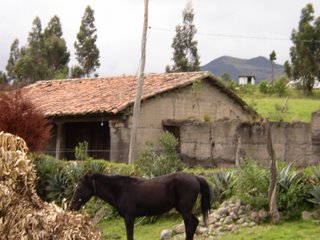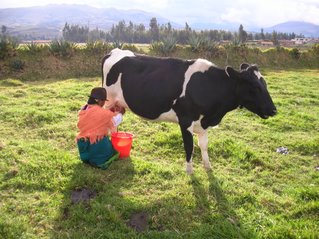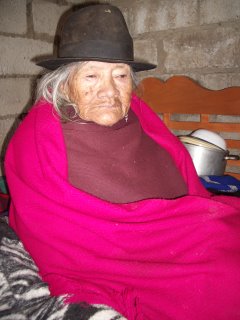Graham Montague an intelligent tourist




Written by Graham Montague
I went with another volunteer and we first caught a bus to Cayambe which is about an hour and a half by bus from Quito. The journey from Cayambe to La Chimba takes an hour by bus along a rough road that is basically a dirt track in places and paved with cobble stones in others. I am told that the buses have to have their suspensions changed every six months! The bus we caught from Cayambe was packed, with a lot of people standing. On the way we passed many small communities along the way and eventually arrived in La Chimba.
We arrived around midday on a Saturday. When we arrived there was a crowd of people laying turf on what is the village football pitch. Apparently it had been a dirt pitch with a large slope and they have now levelled it and are making it into a grass pitch, a task that will take a few months to complete. There seems to be a regular morning work party, many of whom are women. The other volunteer had bought a football on the way and we were soon playing in the street with a couple of children who greeted us enthusiastically. In fact, one of them, Morella (?), is absolutely charming. She is nine years old but has an engaging manner way beyond her years. Perhaps she should be given the job of welcoming visitors to the village.
La Chimba is at an altitude of about 8,000ft(?) and is set in a long broad valley surrounded by mountains. It is a community of about 400 families. The village has one long street with several short side streets off it. In some ways it is a bit like a Wild West town, especially when one of the local caballeros rides along it. Many people seem to have horses and they all look well cared for. The quite elaborate tack is very impressive, especially the decorative traces and the stirrups with built in clogs - I'm not a horseman, so this is not very technical!
The community revolves around dairy production with many people milking befoer dawn and then again at 4.00pm in the afternoon. Because of the early start, people seem to go to bed early.
The cows are often some way from where people live and people either walk to their fields or catch the bus. There are no stalls to milk the cows in, they are milked out in the open with their legs tied together to encourage them to keep still. There is an informal network of lifts for collecting people with their milk and taking them with their containers back to the communal dairy centre. The churns can be heavy but many of the milkers are women of considerable age. They scoop the churns up in a shawl and carry them on their backs. I made hard work of carrying one churn a short distance and over a somewhat rickety wooden bridge. I had a go at milking but managed to spook the cow who trotted off before being made to settled down again. The climate is such that the growing season is all year round. They don't have to cut and store food for animals.
All around the village are patches of rough land where an assortment of animals, including chickens, pigs and sheep, can be found grazing. Sometimes they are tethered, sometimes hobbled (feet tied together with a short rope), and sometimes just loose. Unfortunately, there is a lot of rubbish lying around and this somewhat spoils the bucolic setting. Whilst the village itself can be dry and dusty, the surrounding fields and mountains present a vast patchwork of green, partly cultivated land and partly natural vegetation.
Many of the older women wear traditional clothes with bright skirts and shawls, several layers of bright beads round their necks and a sort of 'pork pie' hat. They often seem to wear quite flimsy shoes but the standard footwear is wellingtons.
While I was at La Chimba I went on two outings. The first was to a hot spring high up in the mountains. A small group of us was taken in a pick-up to a point from where we walked up and down through long grass until we came to the thermal pool. There is a small hut for changing in if you want a little privacy. I chose to change, hopping from foot to foot, on the rocks by the pool. It was a strange but exhilarating experience stripping off and lying in the warm water looking out over a green valley towards mountains beyond.
The second outing was to San Marco lake, again a pick-up ride into the mountains. There is a feeling of such space and openness, winding your way upwards with mountains all around. That morning was very clear and all along the way we could see the snow capped Nevada Cayambe outlined against the clear blue sky. It is a very hypnotic presence and it keeps drawing your eyes back to it. The San Marco lake itself is not spectacular but its setting is. On this outing we had a ride across a river in a metal cradle on a pulley, which gave us a great feeling of adventure.
I had been learning Spanish for only a few weeks and so my language skills were quite limited. I was lucky that there were other volunteers who spoke better Spanish. None of the community seemed to speak any English which is likely to be a bit of a barrier to communicating with visitors. It was discussed that I might start to teach the guides some English but this did not happen - only partly because I was not feeling as well as I would have liked and left La Chimba earlier than planned. Motivation to learn some English might need to be encouraged and a programme agreed with the community.
The house where I stayed was modest, which is to be expected, but it was also very dirty and, in my opinion, not acceptable to paying visitors. Another volunteer stayed in what seemed to be a simple but better looked after home. I think it it is important for the community to ensure that host homes are of a minimum standard and suitable for visitors.
The community is wanting to attract visitors for short stays. People in the community are friendly and happy to involve you in their lives. Some are interested to ask questions about where you come from. Apart from asking you about your family, one common question is how much your currency is worth!
La Chimba is well worth a visit to see how its people go about their modest everyday lives and for you to enjoy and appreciate its beautiful setting.


